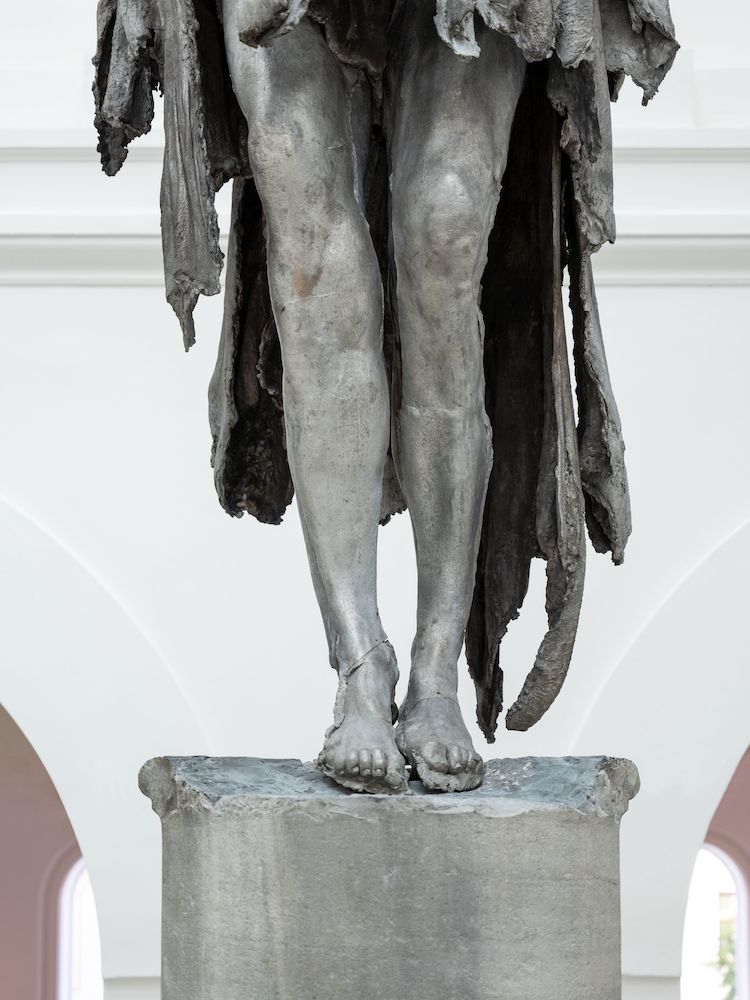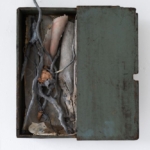Exhibition
in Zürich / Switzerland
- Berlinde De Bruyckere: Arcangelo (Freising), 2021 – 2022 (detail), 2022, Bronze, lead patina, Belgian limestone, steel, Height: 500 cm / 196 7/8 in, installation view, Diözesan Museum, Freising, Germany, Photo Thomas Dashuber / Diözesan Museum, © Berlinde De Bruyckere, Courtesy the artist and Hauser & Wirth
- Berlinde De Bruyckere: It almost seemed a lily, 2019 – 2022, 2022, Tracing paper, thread, pencil, gold dust on paper, 44.8 x 28 cm / 17 5/8 x 11 in, Photo Mirjam Devriendt, © Berlinde De Bruyckere, Courtesy the artist and Hauser & Wirth
- Berlinde De Bruyckere: It almost seemed a lily, 2019 – 2022, 2022, Tracing paper and thread on paper, 44.8 x 28 cm / 17 5/8 x 11 in, Photo Mirjam Devriendt, © Berlinde De Bruyckere, Courtesy the artist and Hauser & Wirth
- Berlinde De Bruyckere: It almost seemed a lily, 2021 – 2023, 2023, Wax, lead, wallpaper, textile, wood, rope, 102 x 83 x 22 cm / 40 1/8 x 32 5/8 x 8 5/8 in, Photo Mirjam Devriendt, © Berlinde De Bruyckere, Courtesy the artist and Hauser & Wirth
Presenting a powerful meditation upon the fundamental human search for transformation, transcendence and reconciliation in the light of mortality, De Bruyckere’s forthcoming exhibition at Hauser & Wirth Zurich, Limmatstrasse will feature new bronze and lead sculptures from the “Arcangelo” series. Alongside these, a selection of monumental, framed relief works and paper collages from the artist’s “It almost seemed a lily” series will be shown. Spanning both painting and sculpture, De Bruyckere works with wax, animal skins, paper, textiles, metal and wood to create hybrid forms with human, animal and plant features. Layering religious iconography and ancient mythology with narratives of transience, carnality and sensuality, Berlinde De Bruyckere surpasses religious connotations and transfers them to the realm of the universal and profane.
Placed high on plinths, De Bruyckere’s “Arcangeli” cast in bronze and lead offer protection, in spite of the heavy burden they seem to carry; captured in a dynamic moment of imbalance, tilting slightly forward, they are at once about to rise up yet are weighed down. Hovering between divine supremacy and human fragility, these mysterious, hybrid figures merge distinct human figuration with animal hides, revealing pointed protrusions at the shoulders that reinforce the suggestion of wings. These beings appear to carry a dark secret under their cloak of fluidly-draped skins and conjure an image as consoling and inviting as it is unnerving.
A powerful tribute to the healthcare workers and caregivers who have provided vital, indispensable consolation and care to millions over the last two years, these works exceed the artist’s long-standing interest in Old Masters and Christian iconography. As the artist movingly stated, ‘Fortunately, there are angels amongst us. I see them everywhere now. … The archetype of the angel, an archaic figure, is entering our lives in a very concrete manner.’ In the work ‘Liggende – Arcangelo I, 2022-2023’, De Bruyckere presents a ‘fallen’ Arcangelo, a figure lying on a monumental tomb-like pedestal topped with a thin layer of black lino, carrying the figure like a separate entity. The use of a zinc sheet for the outer material of the base was inspired by Victorian lead coffins. The idea for the fallen Arcangelo arose from the question the artist asked herself: ‘how much of the other’s burden can one person carry, before they themselves collapse?’ A larger version of the Arcangelo sculptures is on view at the newly reopened Diözesanmuseum Freising in Germany, responding to the museum’s collection of late Gothic sculptures.
Following her recent critically-acclaimed exhibitions at MO.CO. Montpellier Contemporain, France (2022) and the Arp Museum Bahnhof Rolandseck in Remagen, Germany (2022), the artist will also present works from her “It almost seemed a lily” series. Inspired by the richly decorated Enclosed Gardens from Mechelen, Belgium, De Bruyckere realized her own large-scale versions of these 16th-century private altars for worship and meditation. Traditionally made using textiles, silk threads, pearls and semi-precious stones, De Bruyckere, instead, elevates found materials to create her monumental interpretations. Permeated with their own history, wallpaper and blankets provide the backdrop to the flowers and petals, framed by oak planking from the 18th Century. Dominated by the figure of the withering flower, ‘It almost seemed a lily V, 2018’ (2018) and ‘It almost seemed a lily IV, 2017 – 2018’ (2018) show the intertwining of nature and history and offer an overriding sense of fragility in the way they are assembled and layered. ‘I connect the petals of the lilies to images of skin, of flesh; their fragrance to lust and pleasure; their unsavoury smell while wilting to ephemerality and pain,’ the artist explains. The series derives its title from Ovid’s Metamorphoses to describe the purple-coloured flower into which the mortal Hyacinthus – beloved by the god Apollo – was transformed on his tragic death: ‘behold the blood / of Hyacinthus, which had poured out on / the ground beside him and there stained the grass, / was changed from blood; and in its place a flower, / more beautiful than Tyrian dye, sprang up. / It almost seemed a lily, were it not / that one was purple and the other white.’ In light of this, the works transcend the spiritual undertones of the Enclosed Gardens and speak of sublimated desire.
This sense of frailty is also explored in the artist’s new collages of the same name, composed using abstract petals cut from found tracing papers used for embroidery and embossed with flower patterns, which the artist layers and sutures together. Unable to glue the sheets together due to their fragility and transparency, the stitched collages are a prime example of the materials in the work dictating the artistic process, similar to the decision to tie wax flowers to the wall sculptures with rope. There are two groups of collages in the series: one consisting purely of found sheets of tracing paper, the other where the artist has coloured in the flowers with black graphite, erasing or modifying pre-existing shapes into phallic motifs. This erotic reading of the work is deepened with the inclusion of gold dust, symbolising fertility: ‘I was in my room after a day of work, hanging the drawings to take a proper look at them, when the glossy black graphite caught the light in a very particular way,’ remarks De Bruyckere. ‘There was a flicker in the darkness, like shimmering gold, that threw me back to the gold covered figurines in the Enclosed Gardens; to the Virgin Mary holding the unicorn in her lap. Like pieces of a puzzle coming together.’
Born in Ghent, Belgium in 1964, where she currently lives and works, De Bruyckere is profoundly influenced by traditions of the Flemish Renaissance. Drawing from the legacies of the European Old Masters and Christian iconography, as well as mythology and cultural lore, De Bruyckere layers existing histories with new narratives suggested by current events to create a psychological terrain of pathos, tenderness and unease. The dualities of love and suffering, danger and protection, life and death and the human need for understanding are the universal themes De Bruyckere has been dealing with since the beginning of her career. ‘I want to show how helpless a body can be,’ De Bruyckere has said. ‘Which is nothing you have to be afraid of — it can be something beautiful.’
Gallery hours Tue-Fri 11 am – 6 pm, Sat 11 am – 5 pm
Exhibition Duration 26 January – 13 May 2023
Location:
Hauser & Wirth
Limmatstrasse 270
8005 Zürich
Switzerland





